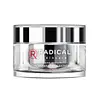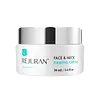What's inside
What's inside
 Key Ingredients
Key Ingredients

 Benefits
Benefits

 Concerns
Concerns

 Ingredients Side-by-side
Ingredients Side-by-side

Water
Skin ConditioningGlycerin
HumectantGlyceryl Stearate Se
EmulsifyingPropanediol
SolventCaprylic/Capric Triglyceride
MaskingIsononyl Isononanoate
EmollientCetyl Alcohol
EmollientButyrospermum Parkii Butter
Skin ConditioningDimethicone
EmollientXylitylglucoside
HumectantBalanites Roxburghii Seed Oil
Skin ConditioningMethyl Methacrylate Crosspolymer
Oryza Sativa Bran Oil
EmollientAnhydroxylitol
HumectantPhenoxyethanol
PreservativePalmitic Acid
EmollientStearic Acid
CleansingTromethamine
BufferingPotassium Cetyl Phosphate
EmulsifyingCarbomer
Emulsion StabilisingHexylresorcinol
AntimicrobialSodium PCA
HumectantVaccinium Macrocarpon Seed Oil
Skin ConditioningCopernicia Cerifera Wax
Hydroxyethyl Acrylate/Sodium Acryloyldimethyl Taurate Copolymer
Emulsion StabilisingXylitol
HumectantOryza Sativa Hull Powder
AbrasiveLimonene
PerfumingSqualane
EmollientChlorphenesin
AntimicrobialDisodium EDTA
Citrus Aurantium Dulcis Peel Oil
MaskingCitrus Tangerina Peel Oil
MaskingO-Cymen-5-Ol
AntimicrobialEuterpe Oleracea Fruit Extract
Pentylene Glycol
Skin ConditioningDecyl Glucoside
CleansingGlucose
HumectantPolysorbate 60
EmulsifyingSodium Dehydroacetate
PreservativeTocopherol
AntioxidantAdenosine
Skin ConditioningHelianthus Annuus Seed Oil
EmollientRosmarinus Officinalis Leaf Extract
AntimicrobialCaprylyl Glycol
EmollientSodium Hyaluronate
HumectantLecithin
EmollientSorbitan Isostearate
EmulsifyingAscorbyl Tetraisopalmitate
AntioxidantNiacinamide
SmoothingPalmitoyl Tripeptide-5
Skin ConditioningPhaeodactylum Tricornutum Extract
HumectantAllantoin
Skin ConditioningXanthan Gum
EmulsifyingAcetyl Hexapeptide-8
HumectantLinalool
PerfumingCamellia Sinensis Leaf Extract
AntimicrobialCoffea Arabica Seed Extract
MaskingSuperoxide Dismutase
AntioxidantWater, Glycerin, Glyceryl Stearate Se, Propanediol, Caprylic/Capric Triglyceride, Isononyl Isononanoate, Cetyl Alcohol, Butyrospermum Parkii Butter, Dimethicone, Xylitylglucoside, Balanites Roxburghii Seed Oil, Methyl Methacrylate Crosspolymer, Oryza Sativa Bran Oil, Anhydroxylitol, Phenoxyethanol, Palmitic Acid, Stearic Acid, Tromethamine, Potassium Cetyl Phosphate, Carbomer, Hexylresorcinol, Sodium PCA, Vaccinium Macrocarpon Seed Oil, Copernicia Cerifera Wax, Hydroxyethyl Acrylate/Sodium Acryloyldimethyl Taurate Copolymer, Xylitol, Oryza Sativa Hull Powder, Limonene, Squalane, Chlorphenesin, Disodium EDTA, Citrus Aurantium Dulcis Peel Oil, Citrus Tangerina Peel Oil, O-Cymen-5-Ol, Euterpe Oleracea Fruit Extract, Pentylene Glycol, Decyl Glucoside, Glucose, Polysorbate 60, Sodium Dehydroacetate, Tocopherol, Adenosine, Helianthus Annuus Seed Oil, Rosmarinus Officinalis Leaf Extract, Caprylyl Glycol, Sodium Hyaluronate, Lecithin, Sorbitan Isostearate, Ascorbyl Tetraisopalmitate, Niacinamide, Palmitoyl Tripeptide-5, Phaeodactylum Tricornutum Extract, Allantoin, Xanthan Gum, Acetyl Hexapeptide-8, Linalool, Camellia Sinensis Leaf Extract, Coffea Arabica Seed Extract, Superoxide Dismutase
Water
Skin ConditioningCamellia Sinensis Leaf Extract
AntimicrobialRubus Fruticosus Leaf Extract
MaskingChamomilla Recutita Flower Extract
MaskingNeopentyl Glycol Diethylhexanoate
EmollientEchinacea Angustifolia Meristem Cell Culture
Skin ConditioningSodium Hyaluronate
HumectantCyclopentasiloxane
EmollientGlycol Distearate
EmollientStearic Acid
CleansingCetearyl Alcohol
EmollientPalmitoyl Tripeptide-4
Skin ConditioningPalmitoyl Tripeptide-5
Skin ConditioningTrifluoroacetyl Tripeptide-2
Skin ConditioningCetyl Alcohol
EmollientButyrospermum Parkii Butter
Skin ConditioningIsostearyl Isostearate
EmollientCetyl Stearate
EmollientTocopherol
AntioxidantHydrolyzed Dna
Skin ConditioningAllantoin
Skin ConditioningPanthenol
Skin ConditioningCaprylic/Capric Triglyceride
MaskingAcrylates/C10-30 Alkyl Acrylate Crosspolymer
Emulsion Stabilising1,2-Hexanediol
Skin ConditioningEthylhexylglycerin
Skin ConditioningWater, Camellia Sinensis Leaf Extract, Rubus Fruticosus Leaf Extract, Chamomilla Recutita Flower Extract, Neopentyl Glycol Diethylhexanoate, Echinacea Angustifolia Meristem Cell Culture, Sodium Hyaluronate, Cyclopentasiloxane, Glycol Distearate, Stearic Acid, Cetearyl Alcohol, Palmitoyl Tripeptide-4, Palmitoyl Tripeptide-5, Trifluoroacetyl Tripeptide-2, Cetyl Alcohol, Butyrospermum Parkii Butter, Isostearyl Isostearate, Cetyl Stearate, Tocopherol, Hydrolyzed Dna, Allantoin, Panthenol, Caprylic/Capric Triglyceride, Acrylates/C10-30 Alkyl Acrylate Crosspolymer, 1,2-Hexanediol, Ethylhexylglycerin
Ingredients Explained
These ingredients are found in both products.
Ingredients higher up in an ingredient list are typically present in a larger amount.
Allantoin is a soothing ingredient known for its protective and moisturizingg properties. Because of this, it is often added to products with strong active ingredients.
Studies show higher concentrations of this ingredient can promote wound healing.
Though it can be derived from the comfrey plant, allantoin is produced synthetically for cosmetic products to ensure purity.
Learn more about AllantoinThis ingredient is also known as shea butter. It is an effective skin hydrator and emollient.
Emollients help soothe and soften your skin. It does this by creating a protective film on your skin. This barrier helps trap moisture and keeps your skin hydrated. Emollients may be effective at treating dry or itchy skin.
Shea butter is rich in antioxidants. Antioxidants help fight free-radicals, or molecules that may harm the body. It is also full of fatty acids including stearic acid and linoleic acid. These acids help replenish the skin and keep skin moisturized.
While Shea Butter has an SPF rating of about 3-4, it is not a sunscreen replacement.
Shea butter may not be fungal acne safe. We recommend speaking with a professional if you have any concerns.
Learn more about Butyrospermum Parkii ButterCamellia Sinensis Leaf Extract is derived from the leaves of the tea plant. Black tea, green tea, and oolong tea are all harvested from this plant.
This ingredient has many skin benefits:
This ingredient contains polyphenols, a strong antioxidant. Antioxidants help fight off molecules that damage skin cells.
On top of that, the antioxidants in green tea neutralize free-radicals from the sun. This gives the skin some extra UV protection, but should not replace sunscreen.
Many components of tea have anti-inflammatory properties.
Polyphenols and L-theanine help soothe the skin and reduce irritation. The caffeine in Camellia Sinensis Leaf Extract helps calm inflamed blood vessels.
Other compounds found in tea include: Vitamin Bs, linoleic acid, magnesium, calcium, iron, and zinc.
Research has shown both drinking Camellia Sinensis Leaf Tea and applying it to the skin can help boost skin elasticity and hydration. Studies also show using tea extract may reduce sebum, or oil, production.
Learn more about Camellia Sinensis Leaf ExtractThis ingredient is an emollient, solvent, and texture enhancer. It is considered a skin-softener by helping the skin prevent moisture loss.
It helps thicken a product's formula and makes it easier to spread by dissolving clumping compounds.
Caprylic Triglyceride is made by combining glycerin with coconut oil, forming a clear liquid.
While there is an assumption Caprylic Triglyceride can clog pores due to it being derived from coconut oil, there is no research supporting this.
Learn more about Caprylic/Capric TriglycerideCetyl Alcohol is a fatty alcohol. Fatty Alcohols are most often used as an emollient or to thicken a product.
Its main roles are:
Though it has "alcohol" in the name, it is not related to denatured alcohol or ethyl alcohol.
The FDA allows products labeled "alcohol-free" to have fatty alcohols.
Learn more about Cetyl AlcoholThis synthetic peptide is created from lysine, valine, and palmitic acid.
According to the manufacturer, in-vitro studies show tissue growth and collagen synthesis. Another in-vivo study found 60 volunteers saw a significant reduction in wrinkles after 84 days.
Due to its palmitic acid base, this peptide may not be fungal-acne safe.
Learn more about Palmitoyl Tripeptide-5Sodium Hyaluronate is hyaluronic acid's salt form. It is commonly derived from the sodium salt of hyaluronic acid.
Like hyaluronic acid, it is great at holding water and acts as a humectant. This makes it a great skin hydrating ingredient.
Sodium Hyaluronate is naturally occurring in our bodies and is mostly found in eye fluid and joints.
These are some other common types of Hyaluronic Acid:
Learn more about Sodium HyaluronateStearic Acid is a fatty acid. It is an emollient, emulsifier, and texture enhancer.
As an emollient, stearic acid helps soften skin. It aids the skin's protective barrier by preventing water loss. It also provides a gentle cleansing effect without stripping away natural oils.
Stearic acid may also be used to enhance the texture of products. It can add volume and stabilize ingredients such as water and oil. This can help water and oil ingredients from separating.
Sources of stearic acid include animal or vegetable fats/oils such as coconut or shea. It can be naturally found in butter, cocoa butter, shea butter, vegetable fats, and animal tallow.
This ingredient may not be Malassezia folliculitis, or fungal-acne safe.
Learn more about Stearic AcidTocopherol (also known as Vitamin E) is a common antioxidant used to help protect the skin from free-radicals and strengthen the skin barrier. It's also fat soluble - this means our skin is great at absorbing it.
Vitamin E also helps keep your natural skin lipids healthy. Your lipid skin barrier naturally consists of lipids, ceramides, and fatty acids. Vitamin E offers extra protection for your skin’s lipid barrier, keeping your skin healthy and nourished.
Another benefit is a bit of UV protection. Vitamin E helps reduce the damage caused by UVB rays. (It should not replace your sunscreen). Combining it with Vitamin C can decrease sunburned cells and hyperpigmentation after UV exposure.
You might have noticed Vitamin E + C often paired together. This is because it is great at stabilizing Vitamin C. Using the two together helps increase the effectiveness of both ingredients.
There are often claims that Vitamin E can reduce/prevent scarring, but these claims haven't been confirmed by scientific research.
Learn more about TocopherolWater. It's the most common cosmetic ingredient of all. You'll usually see it at the top of ingredient lists, meaning that it makes up the largest part of the product.
So why is it so popular? Water most often acts as a solvent - this means that it helps dissolve other ingredients into the formulation.
You'll also recognize water as that liquid we all need to stay alive. If you see this, drink a glass of water. Stay hydrated!
Learn more about Water